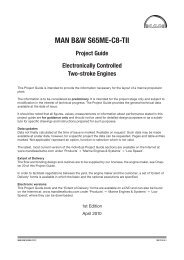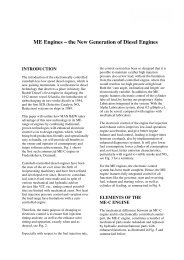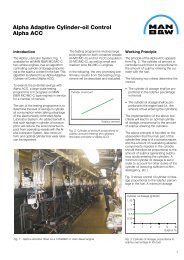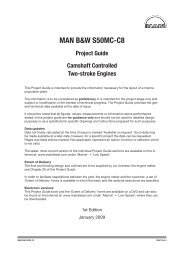This section is available on request - MAN Diesel & Turbo
This section is available on request - MAN Diesel & Turbo
This section is available on request - MAN Diesel & Turbo
Create successful ePaper yourself
Turn your PDF publications into a flip-book with our unique Google optimized e-Paper software.
<strong>MAN</strong> B&W 5.17<br />
Shaftline Earthing Device<br />
Scope and field of applicati<strong>on</strong><br />
A difference in the electrical potential between the<br />
hull and the propeller shaft will be generated due<br />
to the difference in materials and to the propeller<br />
being immersed in sea water.<br />
In some cases, the difference in the electrical<br />
potential has caused spark erosi<strong>on</strong> <strong>on</strong> the thrust,<br />
main bearings and journals of the crankshaft of<br />
the engine.<br />
In order to reduce the electrical potential between<br />
the crankshaft and the hull and thus prevent spark<br />
erosi<strong>on</strong>, a highly efficient shaftline earthing device<br />
must be installed.<br />
The shaftline earthing device should be able to<br />
keep the electrical potential difference below 50<br />
mV DC. A shaft-to-hull m<strong>on</strong>itoring equipment with<br />
a mV-meter and with an output signal to the alarm<br />
system must be installed so that the potential and<br />
thus the correct functi<strong>on</strong> of the shaftline earthing<br />
device can be m<strong>on</strong>itored.<br />
Note that <strong>on</strong>ly <strong>on</strong>e shaftline earthing device <str<strong>on</strong>g>is</str<strong>on</strong>g><br />
needed in the propeller shaft system.<br />
Design descripti<strong>on</strong><br />
The shaftline earthing device c<strong>on</strong>s<str<strong>on</strong>g>is</str<strong>on</strong>g>ts of two silver<br />
slip rings, two arrangements for holding brushes<br />
including c<strong>on</strong>necting cables and m<strong>on</strong>itoring<br />
equipment with a mV-meter and an output signal<br />
for alarm.<br />
The slip rings should be made of solid silver or<br />
back-up rings of cobber with a silver layer all over.<br />
The expected life span of the silver layer <strong>on</strong> the<br />
slip rings should be minimum 5 years.<br />
The brushes should be made of minimum 80%<br />
silver and 20% graphite to ensure a sufficient<br />
electrical c<strong>on</strong>ducting capability.<br />
Res<str<strong>on</strong>g>is</str<strong>on</strong>g>tivity of the silver should be less than 0.1μ<br />
Ohm x m. The total res<str<strong>on</strong>g>is</str<strong>on</strong>g>tance from the shaft to<br />
the hull must not exceed 0.001 Ohm.<br />
<strong>MAN</strong> B&W MC/MC�C, ME/ME�C/ME-GI/ME-B engines<br />
<strong>MAN</strong> <strong>Diesel</strong><br />
Page 1 of 3<br />
Cabling of the shaftline earthing device to the hull<br />
must be with a cable with a cross <str<strong>on</strong>g>secti<strong>on</strong></str<strong>on</strong>g> not less<br />
than 45 mm². The length of the cable to the hull<br />
should be as short as possible.<br />
M<strong>on</strong>itoring equipment should have a 4-20 mA<br />
signal for alarm and a mV-meter with a switch for<br />
changing range. Primary range from 0 to 50 mV<br />
DC and sec<strong>on</strong>dary range from 0 to 300 mV DC.<br />
When the shaftline earthing device <str<strong>on</strong>g>is</str<strong>on</strong>g> working<br />
correctly, the electrical potential will normally be<br />
within the range of 10-50 mV DC depending of<br />
propeller size and revoluti<strong>on</strong>s.<br />
The alarm set-point should be 80 mV for a high<br />
alarm. The alarm signals with an alarm delay of 30<br />
sec<strong>on</strong>ds and an alarm cut-off, when the engine <str<strong>on</strong>g>is</str<strong>on</strong>g><br />
stopped, must be c<strong>on</strong>nected to the alarm system.<br />
C<strong>on</strong>necti<strong>on</strong> of cables <str<strong>on</strong>g>is</str<strong>on</strong>g> shown in the sketch, see<br />
Fig. 5.17.01.<br />
198 49 29�2.4
















